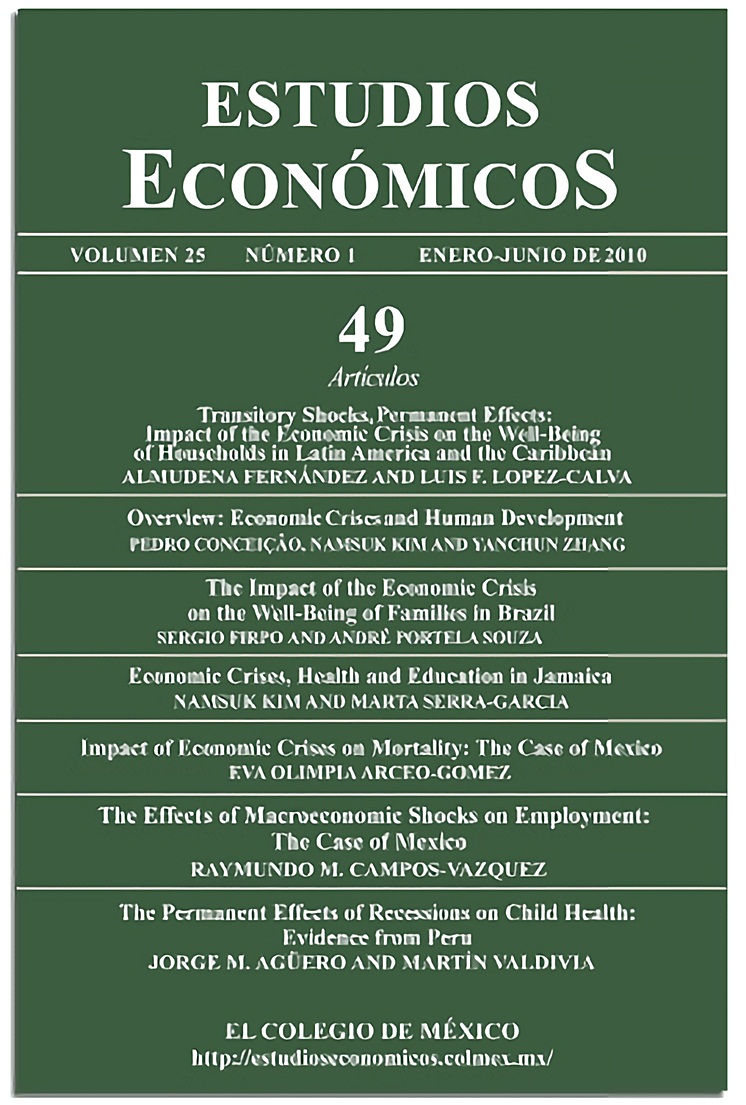Publicado 2010-01-01
Palabras clave
- ciclo económico,
- crisis económica,
- mortalidad,
- Metas del Milenio,
- México
Cómo citar
Resumen
Se analiza el impacto de las crisis económicas en la mortalidad en México. La identificación de este efecto es difícil porque el PIB puede ser una función de la salud. Para resolver dicho problema de endogeneidad proponemos el uso de dos tipos de variables instrumentales del PIB a nivel estado. Nuestros resultados sugieren que una caída del uno por ciento del PIB provocaría un aumento del 0.5 por ciento en la tasa de mortalidad. Los niños y adultos mayores constituyen los grupos más vulnerables. Los resultados implican que la crisis de 2008 devolvió a México a los niveles de mortalidad infantil de 2001, revirtiendo su progreso para alcanzar las metas del Milenio.
Descargas
Citas
- Angrist, J., and A. Kugler. 2003. Protective or Counter-Productive? Labour Market Institutions and the Effect of Immigration on EU Natives, The Economic Journal, 113 (488): 302-331.
- Attanasio, O. P., and M. Szekely. 2004. Wage Shocks and Consumption Variability in Mexico during the 1990s, Journal of Development Economics, 73(1): 1-25.
- Baird, S., J. Friedman, and N. Schady. 2007. Aggregate Income Shocks and Infant Mortality in the Developing World, World Bank, Policy Research Working Paper, no. 4346.
- Bureau of Transportation Statistics. 2010. North American Transborder Freight Data, on line information available at: http://www.bts.gov/programs/international/transborder/TBDR_QA.html.
- Consejo Nacional de Población. 2010. Indicadores demográficas básicos, on line information available at: http://www.conapo.gob.mx/index.php?option=com_content&view=article&id=125&Itemid=203.
- Currie, J., and E. Moretti. 2003. Mother´s Education and the Intergenerational Transmission of Human Capital: Evidence from College Openings, Quarterly Journal of Economics, 118(4): 1495-1532.
- Cutler, D., A. Deaton, and A. Lleras-Muney. 2006. The Determinants of Mortality, The Journal of Economic Perspectives, 20(3): 97-120.
- Cutler, D., et al. 2002. Financial Crisis, Health Outcomes and Ageing: Mexico in the 1980s and 1990s, Journal of Public Economics, 84(2): 279-303.
- Ferreira, F., and N. Schady. 2008. Aggregate Economic Shocks, Child Schooling and Child Health, World Bank, Policy Research Working Paper, no. 4701.
- Frenk, J. 2006. Bridging the Divide: Global Lessons from Evidence-Based Health Policy in Mexico, The Lancet, 368(9539): 954-961.
- Frenk, J., et al. 2003. Evidence-Based Health Policy: Three Generations of Reform in Mexico, The Lancet, 362 (9396): 1667-1671.
- Gerdtham, U., and C. Ruhm. 2006. Deaths Rise in Good Economic Times: Evidence from the OECD, Economics and Human Biology, 4(3): 298-316.
- Gonzales, F., and T. Quast. 2009. Macroeconomic Changes and Mortality in Mexico, Sam Houston State University, Working Paper Series, no. 08-07.
- Granados, J. 2005a. Increasing Mortality during the Expansions of the US Economy, 1900-1996, International Journal of Epidemiology, 34(6): 1194-1202.
- Granados, J. 2005b. Recessions and Mortality in Spain, 1980-1997, European Journal of Population/Revue Européenne de Démographie, 21(4): 393-422.
- Hanson, G. 1998. North American Economic Integration and Industry Location, Oxford Review of Economic Policy, 14(2): 30-44.
- Hanson, G. 1997. Increasing Returns, Trade and the Regional Structure of Wages, The Economic Journal, 107 (440): 113-133.
- Hildebrandt, N., and D. McKenzie. 2005. The Effects of Migration on Child Health in Mexico, Economia, 6(1): 257-289.
- INFOPLEASE. 2010. Atlas, US, on line information available at: http://www.infoplease.com/atlas/calculate-distance.html
- INEGI. 2010. Statistical Surveys, México, on line information available at: http://www.inegi.org.mx/
- IMF. 2009. World Economic Outlook: Crisis and Recovery, World Economic and Financial Surveys, Washington, D. C.
- IMF. 2010. World Economic Outlook Update: A Policy-Driven, Multispeed Recovery, Washington, D.C.
- Kanaiaupuni, S., and K. Donato. 1999. Migradollars and Mortality: The Effects of Migration on Infant Survival in Mexico, Demography, 36(3): 339-353.
- Knaul, F., and J. Frenk. 2005. Health Insurance in Mexico: Achieving Universal Coverage through Structural Reform, Health Affairs, 24(6): 1467-1476.
- Lindeboom, M., G. Van den Berg, and F. Portrait. 2006. Economic Conditions Early in Life and Individual Mortality, The American Economic Review, 96(1): 290-302.
- López-Cordova, E. 2004. Globalization, Migration and Development: The Role of Mexican Migrant Remittances, Economia, 6(1): 217-248.
- Mathers, C., et al. 2005. Counting the Dead and What They Died from: An Assessment of the Global Status of Cause of Death Data, Bulletin of the World Health Organization, 83:171-177.
- McKenzie, D. J. 2006. The Consumer Response to the Mexican Peso Crisis, Economic Development and Cultural Change, 55(1): 139-72.
- McKenzie, D. J. 2003. How Do Households Cope with Aggregate Shocks? Evidence from the Mexican Peso Crisis, World Development, 31(7): 1179-1199.
- Miguel, E. 2005. Poverty and Witch Killing, The Review of Economic Studies, 72(4): 1153-1172.
- Murray, M. 2006. Avoiding Invalid Instruments and Coping with Weak Instruments, Journal of Economic Perspectives, 20(4): 111-132.
- Neumayer, E. 2004. Recessions Lower (Some) Mortality Rates: Evidence from Germany, Social Science & Medicine, 58(6): 1037-1047.
- Pritchett, L., and L. Summers. 1996. Wealthier is Healthier, The Journal of Human Resources, 31(4): 841-868.
- Ruhm, C. J. 2000. Are Recessions Good for Your Health?, Quarterly Journal of Economics, 115(2): 617-650.
- Secretaría de Salud. 2010. Base de datos de defunciones 1979-2007, Sistema Nacional de Información en Salud (SINAIS), on line information available at: http://www.sinais.salud.gob.mx
- Smith, J. 1999. Healthy Bodies and Thick Wallets: The Dual Relation between Health and Economic Status, Journal of Economic Perspectives, 13(2): 145-166.
- Stock, J., M. Yogo, and L. Center. 2002. Testing for Weak Instruments in Linear IV Regression, NBER Technical Working Paper, no. 284.
- Strauss, J., and D. Thomas. 1998. Health, Nutrition, and Economic Development, Journal of Economic Literature, 36 (2): 766-817.
- Torres, A., and F. Knaul. 2003. Determinantes del gasto de bolsillo en salud e implicaciones para el aseguramiento universal en México: 1992-2000, in F. M. Knaul and G. Nigenda (eds.), Caleidoscopio de la salud. De la investigación a las políticas y de las políticas a la acción, México, Fundación Mexicana para la Salud, pp. 209-228.
- United Nations. 2009. The Millennium Development Goals Report, New York.

